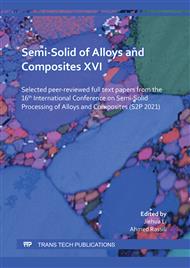p.244
p.250
p.255
p.263
p.272
p.279
p.287
p.293
p.300
Semi-Solid 6061 Aluminum Alloy Slurry Prepared by Serpentine Channel Pouring Process and its Rheo-Diecasting
Abstract:
Semi-solid 6061 aluminum alloy slurry was prepared by a graphite serpentine channel and its rheo-diecasting experiment was carried out on the slurry. The influence of pouring temperature on the microstructure evolution and mechanical properties of the rheo-diecasting were investigated. The microstructure and fracture mechanism of traditional die cast tensile specimens and rheo-diecast tensile specimens were compared and investigated. The results indicate that the microstructure of rheo-diecast tensile specimens is composed of spherical primary α-Al grains and fine secondary solidified α2-Al grains. When the pouring temperature increased from 660 °C to 720 °C, the average equivalent grain diameter of primary α-Al grains increased from 42 μm to 58 μm, and the shape factor decreased from 0.82 to 0.73. As the pouring temperature increases, the as-cast tensile strength and elongation of tensile specimens both increase first and then decrease. When the pouring temperature was 690 °C, the best mechanical properties were obtained, with as-cast tensile strength of 142.93 MPa and as-cast elongation of 4.86%. The fracture mechanism of traditional die casting is mainly ductile fracture, and the fracture mechanism of rheo-diecasting is a mixed fracture of intergranular fracture and ductile fracture.
Info:
Periodical:
Pages:
279-286
Citation:
Online since:
January 2022
Authors:
Keywords:
Price:
Сopyright:
© 2022 Trans Tech Publications Ltd. All Rights Reserved
Share:
Citation:


